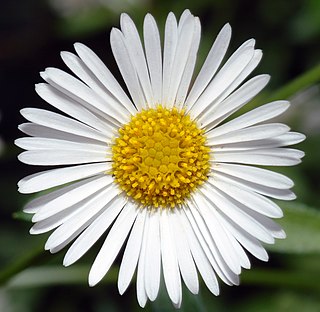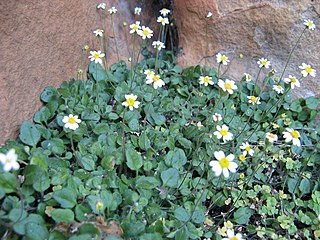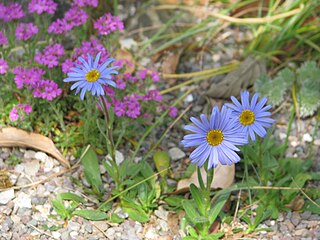
Augustin Pyramusde Candolle was a Swiss botanist. René Louiche Desfontaines launched de Candolle's botanical career by recommending him at a herbarium. Within a couple of years de Candolle had established a new genus, and he went on to document hundreds of plant families and create a new natural plant classification system. Although de Candolle's main focus was botany, he also contributed to related fields such as phytogeography, agronomy, paleontology, medical botany, and economic botany.

Alphonse Louis Pierre Pyramusde Candolle was a French-Swiss botanist, the son of the Swiss botanist Augustin Pyramus de Candolle.

Anne Casimir Pyramusde Candolle was a Swiss botanist, the son of Alphonse Pyramus de Candolle.

Chaenactis is a genus of plants in the family Asteraceae which are known generally as pincushions and dustymaidens.

Olearia axillaris, commonly known as coastal daisy-bush, coast daisy-bush or coastal daisybush is a species of flowering plant in the family Asteraceae and is endemic to coastal areas of Australia. It is an erect, bushy shrub with densely cottony-hairy branchlets, aromatic, linear to narrowly elliptic or narrowly lance-shaped to egg-shaped leaves with the narrower end towards the base and small white and yellow, daisy-like inflorescences.

Erigeron karvinskianus, the Mexican fleabane, is a species of daisy-like flowering plant in the family Asteraceae, native to Mexico and parts of Central America.

Felicia amelloides, the blue daisy bush or blue felicia, is a hairy, soft, usually perennial, evergreen plant, in the family Asteraceae. It can be found along the southern coast of South Africa. It grows as ground cover and produces many very regular branches. It mostly grows to about 50 cm (1.6 ft) high, rarely to 1 m. The leaves are oppositely arranged along the stems, dark green in colour and elliptic in shape. The flower heads sit individually on up to 18 cm (7 in) long, green to dark reddish stalks. They consist of about twelve heavenly blue ray florets that surround many yellow disc florets, together measuring about 3 cm across. It is also cultivated as an ornamental, and was introduced in Europe in the middle of the 18th century.

Felicia filifolia is a Southern African member of the family Asteraceae. It is a hardy, sprawling shrub growing to about 1 metre tall. Leaves are narrow and clustered along the twigs. When blooming it is densely covered in flowerheads with ray florets that are pink-mauve to white and disc florets that are yellow. In the wild, flowers can be found August to December.

Olearia ramulosa, commonly known as twiggy daisy-bush, is a species of flowering plant in the family Asteraceae and is endemic to south-eastern Australia. It is a shrub with narrowly elliptic, linear or narrowly egg-shaped leaves, and pale blue, mauve or white and yellow, daisy-like inflorescences.

Xanthisma, common name sleepy-daisy, is a genus of flowering plants in the family Asteraceae.
Anisochaeta is a genus of flowering plants in the daisy family (Asteraceae).

Corethrogyne is a monotypic genus of flowering plant in the family Asteraceae. Its only species is Corethrogyne filaginifolia, known by the common names common sandaster and California aster.
Microglossa is a genus of Asian and African flowering plants in the tribe Astereae within the family Asteraceae.
Rochonia is a genus of Madagascarian plants in the tribe Astereae within the family Asteraceae.

Felicia cymbalariae, is a hairy perennial herbaceous plant of up to 30 cm (12 in) high in the family Asteraceae. It has creeping branches that bend upwards, stalked leaves of up to 6 × 4½ cm (2.4 × 1.8 in) with few teeth or nearly entire. The flower heads are set individually on top of up to 8 cm (3 in) long stalks and contain about sixteen white ray florets of about 6 × 1½ mm around a center with many yellow or dark wine red disc florets. It can be found in the Western Cape province of South Africa. Flower heads can be found between September and June.

Felicia macrorrhiza is a small, evergreen shrub in the family Asteraceae. This species grows in the Karoo region of South Africa. It is called Aspoestertjie in Afrikaans.

Felicia brevifolia is an evergreen, richly branched shrub of up to 11⁄2 m (5 ft) high, that is assigned to the family Asteraceae. It has elliptic to wedge-shaped leaves, of between 1⁄2 and 11⁄2 cm long, green to gray-green, many with several teeth. The flower heads have about fifteen blue-violet ray florets, encircling many yellow disc florets. This species grows in southern Namibia and the west of South Africa.

Felicia rosulata is a hairy, perennial, herbaceous plant of up to 30 cm (1 ft) high, that is assigned to the family Asteraceae. It has a rosette of elliptic 8 cm × 2 cm leaves with 3–5 veins, and long, hairy stalks, each topped with one floral head consisting of about thirty middle blue ray florets encircling many yellow disc florets. It can be found in the mountains of Lesotho, eastern South Africa and Eswatini.

Felicia bergeriana is a richly branching, hairy annual plant of up to 25 cm (10 in) high that is assigned to the family Asteraceae. It has opposite leaves and flower heads set individually on up to 8 cm long stalks, that consist of an involucre of about 1⁄2 cm diameter with two whorls of bracts, about twelve blue ray florets surrounding more yellow disc florets. It is sometimes called kingfisher daisy in English. It can be found in the Northern and Western Cape provinces of South Africa. It is sometimes cultivated as an ornamental.
Felicia cana is a low and slender shrublet of up to 15 cm high, covered in white felty hairs, that is assigned to the family Asteraceae. It has alternately arranged leaves, and flower heads of about 16 mm (0.63 in) across, with 3–4 whorls of involucral bracts, and about 20 blue purple ray florets, surrounding many yellow disc florets in the centre. Very characteristic for the species are also the middle-long hairs with forked tips on the surface of its fruits. It is an endemic species that is restricted to a zone along the southern coast of the Western Cape province of South Africa.
















